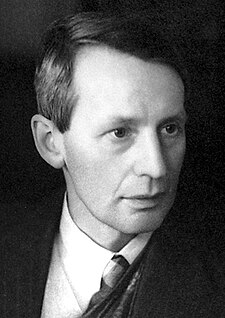Central for Research and Development for Winning
Nobel Prize in Physics at Indonesia
Nobel Fisika Indonesia
Clinton Davisson
George Paget Thomson
Clinton Joseph Davisson
George Paget Thomson
The Nobel Prize in Physics 1937 was awarded jointly to Clinton Joseph Davisson and George Paget Thomson "for their experimental discovery of the diffraction of electrons by crystals"
Photos: Copyright © The Nobel Foundation
| Clinton Joseph Davisson | |
|---|---|
 Davisson | |
| Born | October 22, 1881 Bloomington, Illinois, USA |
| Died | February 1, 1958 (aged 76) Charlottesville, Virginia, USA |
| Nationality | United States |
| Fields | Physics |
| Institutions | Princeton University Carnegie Institute of Technology Bell Labs |
| Alma mater | University of Chicago Princeton University |
| Doctoral advisor | Owen Richardson |
| Known for | Electron diffraction |
| Influenced | Joseph A. Becker William Shockley |
| Notable awards | Comstock Prize in Physics (1928)[1] Elliott Cresson Medal (1931) Nobel Prize in Physics (1937) |
Biography
Early years
Davisson was born in Bloomington, Illinois. He graduated from Bloomington High School in 1902, and entered the University of Chicago on scholarship. Upon the recommendation of Robert A. Millikan, in 1905 Davisson was hired by Princeton University as Instructor of Physics. He completed the requirements for his B.S. degree from Chicago in 1908, mainly by working in the summers. While teaching at Princeton, he did doctoral thesis research with Owen Richardson. He received his Ph.D. in physics from Princeton in 1911; in the same year he married Richardson's sister, Charlotte.[2][3]Career
Davisson was then appointed as an assistant professor at the Carnegie Institute of Technology. In 1917 he took a leave from the Carnegie Institute to do war-related research with the Engineering Department of the Western Electric Company (later Bell Telephone Laboratories). At the end of the war, Davisson accepted a permanent position at Western Electric after receiving assurances of his freedom there to do basic research. He had found that his teaching responsibilities at the Carnegie Institute largely precluded him from doing research.[2] Davisson remained at Western Electric (and Bell Telephone) until his formal retirement in 1946. He then accepted a research professor appointment at the University of Virginia that continued until his second retirement in 1954.[2]- Electron Diffraction and the Davisson-Germer Experiment
| Sir George Paget Thomson | |
|---|---|
 | |
| Born | 3 May 1892 Cambridge, England |
| Died | 10 September 1975 (aged 83) Cambridge, England |
| Nationality | United Kingdom |
| Fields | Physics |
| Institutions | University of Aberdeen University of Cambridge Imperial College London |
| Alma mater | University of Cambridge |
| Doctoral advisor | John Strutt (Rayleigh) |
| Doctoral students | Ishrat Hussain Usmani |
| Known for | Electron diffraction |
| Notable awards | Howard N. Potts Medal (1932) Nobel Prize in Physics (1937) |
Sir George Paget Thomson, FRS (3 May 1892 – 10 September 1975) was an English physicist and Nobel laureate in physics recognised for his discovery with Clinton Davisson of the wave properties of the electron by electron diffraction.
Biography
Thomson was born in Cambridge, England, the son of physicist and Nobel laureate J. J. Thomson and Rose Elisabeth Paget, the daughter of the professor of medicine at the University of Cambridge. Thomson went to The Perse School, Cambridge before going onto read mathematics and physics at Trinity College, Cambridge, until the outbreak of World War I in 1914, when he was commissioned into the Queen's Royal West Surrey Regiment. After brief service in France, he worked on aerodynamics at Farnborough and elsewhere. He resigned his commission as a Captain in 1920.
In 1924, Thomson married Kathleen Buchanan Smith, daughter of the Very Rev. Sir George Adam Smith. They had four children, two sons and two daughters. Kathleen died in 1941.
Career
After briefly serving in the First World War Thomson became a Fellow at Cambridge and then moved to the University of Aberdeen. George Thomson was jointly awarded the Nobel Prize for Physics in 1937 for his work in Aberdeen in discovering the wave-like properties of the electron. The prize was shared with Clinton Joseph Davisson who had made the same discovery independently. Whereas his father had seen the electron as a particle (and won his Nobel Prize in the process), Thomson demonstrated that it could be diffracted like a wave, a discovery proving the principle of wave-particle duality which had first been posited by Louis-Victor de Broglie in the 1920s as what is often dubbed the de Broglie hypothesis.
In 1930 he was appointed Professor at Imperial College in the chair of the late Hugh Longbourne Callendar. In the late 1930s and during the Second World War Thomson specialised in nuclear physics, concentrating on practical military applications. In particular Thomson was the chairman of the crucial MAUD Committee in 1940–1941 that concluded that an atomic bomb was feasible. In later life he continued this work on nuclear energy but also wrote works on aerodynamics and the value of science in society.
Thomson stayed at Imperial College until 1952, when he became Master of Corpus Christi College, Cambridge. In 1964, the college honoured his tenure with the George Thomson Building, an outstanding work of modernist architecture on the college's Leckhampton campus.
Thomson was knighted in 1943.
Sumber:
1. Wikipedia
2. Nobel Prize Org.
Ucapan Terima Kasih:
Ucapan Terima Kasih:
1. DEPDIKNAS Republik Indonesia
2. Kementrian Riset dan Teknologi Indonesia
3. Lembaga Ilmu Pengetahuan Indonesia (LIPI)
4. Akademi Ilmu Pengetahuan Indonesia
5. Tim Olimpiade Fisika Indonesia
Disusun Ulang Oleh:
Arip Nurahman
Pendidikan Fisika, FPMIPA, Universitas Pendidikan Indonesia
&
Follower Open Course Ware at MIT-Harvard University, USA.

























